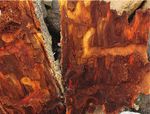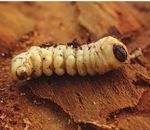Screening Aid - IDTools.org
←
→
Page content transcription
If your browser does not render page correctly, please read the page content below
Screening Aid City Longhorn Beetle
Aeolesthes sarta (Solsky)
Hanna R. Royals and Todd M. Gilligan
Identification Technology Program (ITP) / Colorado State University, USDA-APHIS-PPQ-Science & Technology (S&T), 2301 Research
Boulevard, Suite 108, Fort Collins, Colorado 80526 U.S.A. (Emails: Hanna.H.Royals@aphis.usda.gov; Todd.M.Gilligan@aphis.usda.gov)
This CAPS (Cooperative Agricultural Pest Survey) screening aid produced for and distributed by:
Version 2.0
USDA-APHIS-PPQ National Identification Services (NIS)
29 Jan 2019
This and other identification resources are available at: https://caps.ceris.purdue.edu/taxonomic-services
The city longhorn beetle, Aeolesthes sarta (Solsky), is a wood-boring
beetle in the family Cerambycidae that occurs in India (Western
Himalayas), northern Pakistan, Afghanistan, Iran, Turkmenistan,
Uzbekistan, Tajikistan, and southern Kyrgyzstan. Cerambycid
adults are highly variable but can usually be identified by their long
antennae, absence of a beak, and characteristic tarsi.
Larvae of A. sarta cause extensive damage to host trees by feeding
on tissues under the bark. They are known to attack both stressed
and healthy trees, and only a few larvae are capable of killing a host
tree in 2–4 years because of their large size and voracious appetite.
In addition, the large larval galleries and boring holes severely
decrease the commercial value of the wood. The city longhorn beetle
is highly polyphagous, and while the preferred hosts are species of
walnut (Juglans L., Juglandaceae), they have been recorded feeding Fig. 1: Adult male of Aeolesthes sarta.
on a wide range of deciduous tree species in many families, including: (Photo from Kadyrov et al. 2016)
Aceraceae, Betulaceae, Fabaceae, Fagaceae, Hippocastanaceae,
Oleaceae, Rosaceae, Salicaceae, and Ulmaceae. The widespread
availability of host plants in North America makes the introduction of
this pest a high risk, although Florida is the only state with a climate
similar to the beetle’s native range.
Adults of the city longhorn beetle are 2.8–4.7 cm in length. They are
dark reddish brown with their elytra covered in fine, shining white Fig. 2: Larval damage from Aeolesthes
pubescence. They are characterized by their large kidney-shaped sarta. (Photo from Kadyrov et al. 2016)
eyes, thick and wrinkled antennal scape, and pronotum that narrows
apically and is transversely wrinkled. Males are generally smaller than
females and have antennae twice as long as their body, while female
antennae do not extend past apices of elytra. With their large size and
characteristic appearance, these beetles are unlikely to be confused
with any native North American species. Detection is perfomed
by visual inspection of wood, where their presence is indicated
by large exit holes, dust from larval boring, and presence of dead
branches and rotting bark. Any suspect cerambycid matching this Fig. 3: Late instar larva of Aeolesthes sarta.
(Photo from Kadyrov et al. 2016)
description and of a similar size should be submitted for professional
identification.
COLEOPTERA 1 CERAMBYCIDAESorting City Longhorn Beetle
Aeolesthes sarta (Solsky)
Suspect trees or timber should be inspected for adult beetles of the appropriate size, color, and shape. Beetles
meeting all of the following requirements should be moved to Level 1 Screening (Page 3):
1) Beetles are approximately 2–5 cm (0.78–2.0 inches) long (Fig. 4)
2) Beetles have an overall shape that is similar to the adults depicted in Figs. 4–7.
3) Beetles are a dark reddish brown, with dense white pubescence (Figs. 5–7, 9). (This pubescence
may be rubbed off on older individuals.)
Fig. 5: Lateral view of an adult male of Aeolesthes sarta.
Fig. 4: Dorsal view of an adult male of Aeolesthes
sarta (Acutal size).
Fig. 6: Lateral view of an adult female of Aeolesthes sarta.
Fig. 7: Dorsal view of an adult female of
Aeolesthes sarta.
COLEOPTERA 2 CERAMBYCIDAELevel 1 Screening City Longhorn Beetle
Aeolesthes sarta (Solsky)
Beetles that meet the sorting requirements should be screened for
suspect cerambycids. Level 1 Screening includes species-specific
characters used in the identification of Aeolesthes sarta adults.
The city longhorn beetle can be identified by the following
combination of characters:
1) Antennae with scape that is thickened and wrinkled in
appearance (Fig. 8).
2) Eyes kidney-shaped (Fig. 8).
3) Elytra covered with a fine, silvery pubescence. Shiny
silvery spots form two irregular bands crossing the elytra
(Fig. 9).
4) Five visible abdominal segments, first segment large, Fig. 8: Head of Aeolesthes sarta male, showing
its middle portion protruding between the hind pair of legs. thick wrinkled scape of antennae, and large
kidney-shaped eyes.
Second, third, and fourth segments approximately equal to
each other but smaller than the first. Last segment triangular
and tapering (Fig. 10).
Beetles meeting the above criteria should be pinned and clearly
labeled before being sent to a trained coleopterist for final
identification.
Fig. 9: Silvery pubescence on adult elytra of
Aeolesthes sarta.
Fig. 10: Visible abdominal segments on adults
of Aeolesthes sarta.
COLEOPTERA 3 CERAMBYCIDAEReferences City Longhorn Beetle
Aeolesthes sarta (Solsky)
Citation
Royals, H. R. and T. M. Gilligan. 2019. Screening aid: City longhorn beetle, Aeolesthes sarta (Solsky).
Identification Technology Program (ITP), USDA-APHIS-PPQ-S&T, Fort Collins, CO. 4 pp.
References for more information on Aeolesthes sarta
European and Mediterranean Plant Protection Organization. 2005. Data sheets on quarantine pests:
Aeolesthes sarta. OEPP/EPPO Bulletin 35: 387–389.
Kadyrov, A. Kh., L. Karpiński, W. T. Szczepański, A. Taszakowski and M. Walczak. 2016. New data
on distribution, biology, and ecology of longhorn beetles from the area of west Tajikistan (Coleoptera,
Cerambycidae). ZooKeys 606: 41–64. doi:10.3897/zookeys.606.9190
Pinkerton, M. and A. Hodges. 2016. City longhorned beetle – Aeolesthes sarta. Accessed 3 May 2018
from www.protectingusnow.org.
Sajad A. K., B. Sanjay and T. Narinder. 2013. Entomological Investigation on Aeolesthes sarta
(Solsky), A major pest on walnut trees (Juglans regia L.) in Kashmir Valley. Journal of Academia and
Industrial Research 25: 325–330.
Zhaurova, K. 2009. Aeolesthes sarta Cerambycidae: City longhorned beetle. Accessed 3 May 2018
from http://download.ceris.purdue.edu/file/90.
Acknowledgments
We would like to thank USDA-APHIS-PPQ National Identification Services and the USDA-APHIS-
PPQ-S&T Identification Technology Program for support of this work. Funding for this project was
provided to H. Royals through section 10007 of the 2014 Farm Bill.
COLEOPTERA 4 CERAMBYCIDAEYou can also read



























































